Unit 2: Canada the Good? Anti-Black Racism in Canadian History
Week 4 – Day 1 – Demonizing Black Bodies
Today, you will explore the history of anti-Blackness in Canada, connect this history to the lived experiences of Black people in Canada, and delve into how this history has been erased in an effort to make Canada look “good”.
Required Material
- Maynard, R. (2017). Policing Black lives: The colour line. Briarpatch, 46(6). [link]
- Miller, J. (2020). Why the Black struggle in Canada has all but been erased. Two historians explain our blind spot. Toronto Star. [link]
- Bingham, R. (2013). Viola Desmond. In The Canadian Encyclopedia. [link]
- Gilbert, J. & Gilbert, L. (2020, February 28). Gilberts: Hugh Burnett and the National Unity Association. Chatham Daily News. [link]
- Julian Biggs (1954). Dresden Story. National Film Board of Canada. [link]
<sub-headings, summaries, resource references and links, videos, pictures, etc.>
The Colour Line
[this article is an excerpt from the Policing Black Lives book, but I don’t know exactly which part, because I do not have the book] — it is from Chapter 2 (demonizing black bodies)
This article introduces many key ideas we will continue to explore throughout this unit, including the significance of Canada’s Jim Crow laws (versus what is commonly thought of as Jim Crow in the U.S. after the civil war). This era produced language and practices that publicly separated Black people from white people. During this time, Blackness became synonymous with subservience, criminality, lack of intelligence, and danger.
Dresden, Ontario

Summary of Gilbert & Gilbert (2020):
In 1948, Hugh Burnett and more than 100 local citizens formed the National Unity Association in an attempt to prevent local businesses in Dresden, Ontario from barring Black citizens from their establishment. By 1954, the NUA’s work led to the Ontario Legislature passing the Fair Accommodations Practices Act that ensured legal action be taken against businesses who practiced this discrimination.
Even after this monumental accomplishment, the passing of this act was ignored by some businesses in Dresden and the surrounding community and made life quite dangerous for Black people and specifically for members of the NUA.
From the National Film Board of Canada:
National Film Board of Canada. (2010). Dresden Story. National Film Board of Canada. Retrieved February 1, 2022, from https://www.nfb.ca/film/dresden_story/
- This film visits the small southwestern Ontario town of Dresden in 1954, surveying the townspeople about local integration practices and their attitudes toward racial discrimination.

Viola Desmond
 Viola Desmond was a civil rights activist and businesswoman in Nova Scotia through the early- and mid-1900s. Similar to the often-told story of Rosa Parks refusing to yield her bus seat to a white patron (1955), Desmond refused to leave a “Whites-only” section of a Nova Scotian theatre in 1946. She was dragged out of the establishment, jailed overnight, and eventually convicted for a tax offense. Although she was pardoned posthumously in 2010, and appeared on the Canadian $10 bill in 2018, Desmond lived the rest of her life with these charges on her record. Read her full story here, and watch the Heritage Minutes video below.
Viola Desmond was a civil rights activist and businesswoman in Nova Scotia through the early- and mid-1900s. Similar to the often-told story of Rosa Parks refusing to yield her bus seat to a white patron (1955), Desmond refused to leave a “Whites-only” section of a Nova Scotian theatre in 1946. She was dragged out of the establishment, jailed overnight, and eventually convicted for a tax offense. Although she was pardoned posthumously in 2010, and appeared on the Canadian $10 bill in 2018, Desmond lived the rest of her life with these charges on her record. Read her full story here, and watch the Heritage Minutes video below.
Historic Canada. (2016). Heritage Minutes: Viola Desmond. YouTube. Retrieved February 14, 2022, from https://youtu.be/ie0xWYRSX7Y.
Required Assessment!
 This week you are asked to complete your second ePortfolio Reflection. You may revisit the ePortfolio information section if you need more guidance for your submission.
This week you are asked to complete your second ePortfolio Reflection. You may revisit the ePortfolio information section if you need more guidance for your submission.
ePortfolio: Points of Encounter with the N-word (6%)
You are asked to watch Elizabeth Stordeur Pryor’s TedTalk “Why it’s so hard to talk about the N-word” and then complete the following exercise for your ePortfolio submission.
- In what ways did Dr. Stordeur Pryor’s TedTalk expand your understanding of the N-word?
- Why is it hard to talk about the N-word?
- What is your personal history around this word?
- What are your points of encounter with the N-word?
Optional Material
- Who was Jim Crow? [video]
- Jean-baptiste, R., & Neuhauser, D. (2002). Segregation. In L. Breslow (Ed.), Encyclopedia of Public Health (Vol. 4, pp. 1084-1085). Macmillan Reference USA. https://link.gale.com/apps/doc/CX3404000769/GVRL?u=wind05901&sid=bookmark-AONE&xid=858bf3b6 (further understanding of Jim Crow and segregation in a U.S. context).
- Henry, N. (2019). Racial Segregation of Black People in Canada. The Canadian Encyclopedia.
- references
- summaries/descriptions
https://www.nfb.ca/film/dresden_story/embed/player/
Dresden Story, Julian Biggs, provided by the National Film Board of Canada

